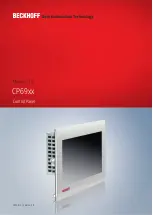
Product overview
CP69xx
11
Version: 3.0
3.2.1
DVI Extended input
The Control Panel has a DVI Extended input (X101). It is used to transmit the graphics signal from the
Industrial PC to the Control Panel.
The graphics signal is transferred directly via a DVI cable over a distance of 50 m max. Such a cable length
leads to strong distortion of the graphics signal on arrival at the Control Panel. A signal processor is used in
the Control Panel to fully restore the DVI signal. The Industrial PC requires a conventional DVI output.
1
8
16
24
17
9
X101
Fig. 3: CP69xx_DVI-E input Pin numbering
Table 2: DVI Extended interface pin assignment
Pin
Connection
Pin
Connection
Pin
Connection
1
TDMS Data 2 -
9
TDMS Data 1 -
17
TDMS Data 0 -
2
TDMS Data 2 +
10
TDMS Data 1 +
18
TDMS Data 0 +
3
TDMS Data 2/4 Shield
11
TDMS Data 1/3 Shield
19
TDMS Data 0/5 Shield
4
TDMS Data 4 -
12
TDMS Data 3 -
20
TDMS Data 5 -
5
TDMS Data 4 +
13
TDMS Data 3 +
21
TDMS Data 5 +
6
DDC Clock
14
+ 5V Power
22
TDMS Clock Shield
7
DDC Data
15
Ground (+ 5 V, Analog H/V
Sync)
23
TDMS Clock +
8
Analog Vertical Sync
16
Hot Plug Detect
24
TDMA Clock -
C5
GND
Setting the Transmission Rate
If the distance between the PC and the Control Panel is large, the transfer rate for the DDC file must be
limited. The DDC file is transferred from the Control Panel to the PC to tell the PC the properties of the
display such as timing and resolution.
The VideoBIOS in the graphics card, or in case of on-board graphics the VideoBIOS in the motherboard,
contains the definition of the transfer rate for the DDC file. This value must be 50 kHz or less. If this value is
too high, the image is either not displayed or only displayed after Windows starts.
Windows graphics drivers also contain a value for the transfer rate of the DDC file. If no image is displayed
under Windows, a graphic driver must be used that contains a value of 50 kHz or less for the DDC file
transfer.












































